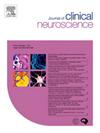Halo牵引评价遗传性结缔组织疾病患者颅颈不稳定:病例系列。
IF 1.9
4区 医学
Q3 CLINICAL NEUROLOGY
引用次数: 0
摘要
颅颈不稳定性(CCI)是结缔组织疾病(如ehers - danlos综合征(EDS))患者中常见的一种疾病,可导致各种症状。由于eds相关症状的复杂性,评估手术融合作为CCI治疗的患者具有挑战性。本研究旨在评估融合前halo-vest牵引在缓解症状和确定融合手术合适人选方面的作用。方法:2019年至2024年期间,有神经系统症状的EDS患者(n = 21)接受了halo-vest牵引。患者在halo-vest牵引前后完成CCI问卷,报告头痛、视力、听力、平衡和功能相关症状。根据患者的反应给症状组打分,每个肯定答案得一分。使用配对学生t检验对前后得分进行分析。大多数症状改善超过50%的患者可考虑进行最终融合手术。21例患者中有16例随后行CCI融合术。结果:患者平均年龄35岁,男女比例为20:1,与已有文献一致。光晕背心牵引后,各症状组均有显著改善,包括头痛(改善57%)。结论:光晕背心牵引被证明是一种简单有效的评估患者手术的方法,同时可缓解eds相关CCI病例的症状。它允许外科医生在手术前监测患者的后光晕稳定颅颈连接(CCJ)。本文章由计算机程序翻译,如有差异,请以英文原文为准。
Halo traction evaluation of craniocervical instability in hereditary connective tissue disorder patients: Case series
Introduction
Craniocervical instability (CCI) is a condition commonly found in patients with connective tissue disorders such as Ehlers-Danlos Syndrome (EDS), leading to various symptoms. Assessing patients for surgical fusion as a treatment for CCI is challenging due to the complex nature of EDS-related symptoms. This study aimed to evaluate the role of pre-fusion halo-vest traction in alleviating symptoms and determining suitable candidates for fusion surgeries.
Methods
EDS patients (n = 21) with neurological symptoms underwent insertion of halo-vest traction between 2019 and 2024. Patients completed a CCI Questionnaire before and after the halo-vest traction, reporting symptoms related to headache, vision, hearing, equilibrium, and function. Symptom groups were assigned scores based on patient responses, with one point for each affirmative answer. Before and after scores were analyzed using paired Student’s t-test. Patients experiencing over 50 % improvement in the majority of symptoms were considered for definitive fusion surgery. 16 out of 21 patients subsequently underwent fusion for CCI.
Results
The average age of the patients was 35 years, with a female-to-male ratio of 20:1, consistent with existing literature. Significant improvements were observed in various symptom groups after halo-vest traction, including headache (57 % improvement, p < 0.001), brainstem functions (71 % improvement, p < 0.001), cerebellar functions (55 % improvement, p < 0.001), hearing (63 % improvement, p < 0.001), motor functions (51 % improvement, p < 0.001), vision (60 % improvement, p < 0.001), cardiovascular functions (46 % improvement, p < 0.05), sensory and pain (53 % improvement, p < 0.001), high cortical functions (54 % improvement, p < 0.001), GI functions (52 % improvement, p < 0.05), bladder functions (52 % improvement, p < 0.05), and Modified Karnofsky score (30 % improvement, p < 0.05).
Conclusion
Halo-vest traction proved to be a simple and effective method for evaluating patients for surgery while providing symptomatic relief in EDS-related CCI cases. It allows surgeons to monitor patients with a now post halo stable craniocervical junctions (CCJ) before committing to surgery.
求助全文
通过发布文献求助,成功后即可免费获取论文全文。
去求助
来源期刊

Journal of Clinical Neuroscience
医学-临床神经学
CiteScore
4.50
自引率
0.00%
发文量
402
审稿时长
40 days
期刊介绍:
This International journal, Journal of Clinical Neuroscience, publishes articles on clinical neurosurgery and neurology and the related neurosciences such as neuro-pathology, neuro-radiology, neuro-ophthalmology and neuro-physiology.
The journal has a broad International perspective, and emphasises the advances occurring in Asia, the Pacific Rim region, Europe and North America. The Journal acts as a focus for publication of major clinical and laboratory research, as well as publishing solicited manuscripts on specific subjects from experts, case reports and other information of interest to clinicians working in the clinical neurosciences.
 求助内容:
求助内容: 应助结果提醒方式:
应助结果提醒方式:


